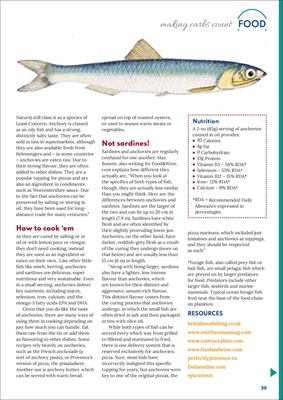
39
FOOD
making carbs count
Nutrition
A 2-oz (45g) serving of anchovies
canned in oil provides:
95 Calories
4g Fat
0 Carbohydrate
13g Protein
Vitamin B3 ~ 56% RDA*
Selenium ~ 55% RDA*
Vitamin B12 ~ 15% RDA*
Iron~ 12% RDA*
Calcium ~ 8% RDA*
* RDA = Recommended Daily
Allowance expressed in
percentages.
pizza marinara, which included just
tomatoes and anchovies as toppings,
and they should be respected
as such."
*Forage fish, also called prey fish or
bait fish, are small pelagic fish which
are preyed on by larger predators
for food. Predators include other
larger fish, seabirds and marine
mammals. Typical ocean forage fish
feed near the base of the food chain
on plankton.
RESOURCES
britishseafishing.co.uk
www.smithsonianmag.com
www.instructables.com
www.foodandwine.com
perfectlyprovence.co
Deliaonline.com
epicurious
Nature) still class it as a species of
Least Concern. Anchovy is classed
as an oily fish and has a strong,
distinctly salty taste. They are often
sold in tins in supermarkets, although
they are also available fresh from
fishmongers and - in some countries
- anchovies are eaten raw. Due to
their strong flavour, they are often
added to other dishes. They are a
popular topping for pizzas and are
also an ingredient in condiments
such as Worcestershire sauce. Due
to the fact that anchovies can be
preserved by salting or storing in
oil, they have been used for longdistance
trade for many centuries."
How to cook 'em
As they are cured by salting or in
oil or with lemon juice or vinegar,
they don't need cooking, instead
they are used as an ingredient or
eaten on their own.. Like other little
fish like smelt, herring, anchovies
and sardines are delicious, super
nutritious and very sustainable. Even
in a small serving, anchovies deliver
key nutrients, including niacin,
selenium, iron, calcium, and the
omega-3 fatty acids EPA and DHA.
Given that you do like the taste
of anchovies, there are many ways of
using them in cooking depending on
just how much you can handle. Eat
them raw from the tin or add them
as flavouring to other dishes. Some
recipes rely heavily on anchovies,
such as the French anchoiade (a
sort of anchovy paste), or Provence's
version of pizza, the pissaladiere.
Another use is anchovy butter, which
can be served with warm bread,
spread on top of roasted oysters,
or used to season warm meats or
vegetables.
Not sardines!
Sardines and anchovies are regularly
confused for one another. Max
Bonem, also writing for Food&Wine.
com explains how different they
actually are, "When you look at
the specifics of both types of fish,
though, they are actually less similar
than you might think. Here are the
differences between anchovies and
sardines. Sardines are the larger of
the two and can be up to 20 cm in
length (7.9 in). Sardines have white
flesh and are often identified by
their slightly protruding lower jaw.
Anchovies, on the other hand, have
darker, reddish-grey flesh as a result
of the curing they undergo (more on
that below) and are usually less than
15 cm (6 in) in length.
"Along with being larger, sardines
also have a lighter, less intense
flavour than anchovies, which
are known for their distinct and
aggressive, umami-rich flavour.
This distinct flavour comes from
the curing process that anchovies
undergo, in which the small fish are
often dried in salt and then packaged
in tins with olive oil.
While both types of fish can be
served every which way from grilled
to filleted and marinated to fried,
there is one delivery system that is
reserved exclusively for anchovies:
pizza. Sure, most kids have
incorrectly maligned this specific
topping for years, but anchovies were
key to one of the original pizzas, the